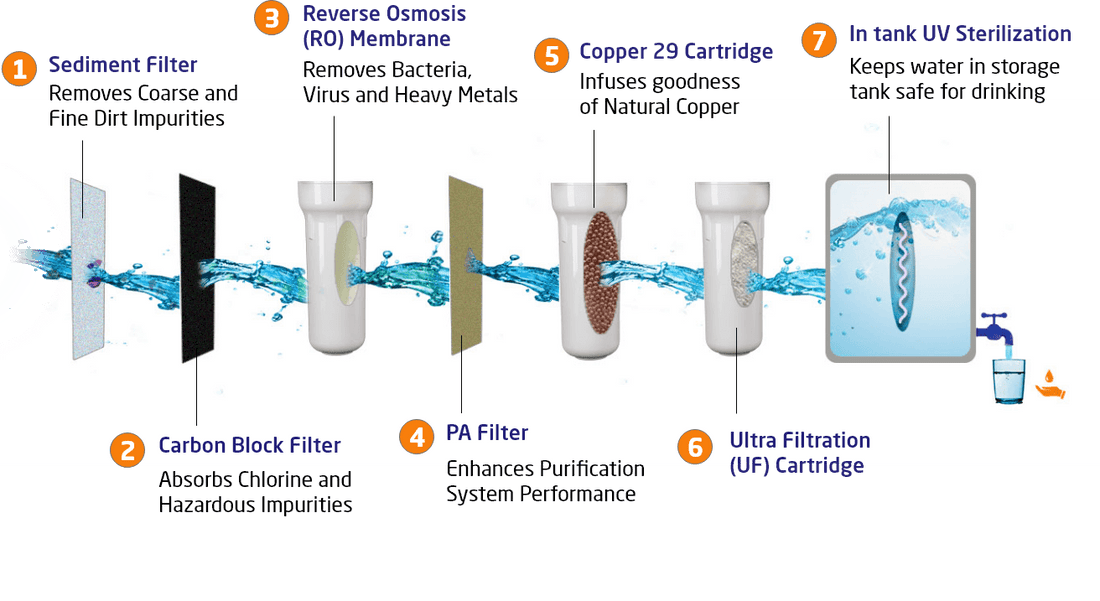Every human being deserves to have clean drinking water as contamination can cause severe illnesses that can sometimes turn fatal. A good quality commercial water filter in offices and schools can prevent people from falling prey to water-borne diseases. If you think your tap water is unsafe, make sure you have an efficient water purifier at home to ensure the wellbeing of your family.
A good water purifier needs to have a filtration technology capable of getting rid of most of the impurities.
Here are the various filters that are used in the multi-stage filtration system used by competent water purifiers –
1. Pre-Filter
A pre-filter is used to filter dust, pollen, fibres, and other visible impurities before further purification by other filters. This filter also prevents these physical impurities from clogging the purifier, thus extending the life of your purifier.
Pre-Filters are usually made from food grade polypropylene fibre, which is non-biodegradable. Generally, these inexpensive filters are removable and can often be replaced so that the water purification is not affected.
2. Sediment Water Filter
This filter is used to filter coarse and very fine particles in the water. Check if your sediment filter has multiple layers to ensure effective purification.
Sediment filters are typically made from polypropylene and can also remove insoluble substances in water. The sediments that make the water cloudy and tiny particles that are less than the size of 1 micron can be trapped by these filters.
3. Activated Carbon Water Filter
These filters are based on Charcoal and remove impurities by a process called adsorption. The internal surface area of these filters with activated carbon granules can attract organic compounds and other chemical contaminants, thereby removing them.
Chlorine and pesticides in the water can also be trapped by this filter. This helps in removing unpleasant odour and the chemical taste of water.
4. Reverse Osmosis Membrane
This polymer film membrane with tiny pores eliminates salt, nitrates, limescale, and other contaminants. An electric pump pressurizes the water to pass through the membrane and the impurities retained in the membrane are flushed through an outlet.
In India, Chlorine is commonly used to treat water before supply. Sometimes, chemicals like Trihalomethanes (THM) are formed due to the reaction of chlorine with organic matter in water. High levels of THM can be hazardous for health. Reverse Osmosis (RO) membrane can remove THMs and are also helpful in eliminating pesticides and herbicides.
There are microorganisms in contaminated water that are primarily responsible for causing diseases like diarrhoea, Gastroenteritis, and Hepatitis E. RO membrane can prevent these diseases by removing the bacteria, protozoa, and viruses present in water.
4. Ultraviolet Radiation
This filter uses shortwave ultraviolet radiation to target the DNA cells of microbes in water. The radiation is powerful enough to kill pathogens in water and prevent them from reproducing.
Ultraviolet radiation is a chemical-free method used to disinfect water and hence doesn’t leave any aftertaste in the water. Since the UV filter can kill 99% of germs, it can be found in some of the best water purifier in India.
5. Ultrafiltration Membrane
Ultrafiltration (UF) membranes are mostly used for post filtration to remove the pathogens like giardia and cysts, so that clean water is obtained on the other end of the membrane. This membrane has larger pores when compared to RO membrane and can remove suspended impurities, thus facilitating clearer water.
6. Carbon Cartridge Impregnated with Silver
The silver in this filter can stop the regrowth of bacteria to provide drinking water that is safe for consumption. This filter can remove volatile organic compounds, rust, and scale, thus eliminating bad odour and taste from the water.
7. Antioxidant Cartridge Water Filter
Antioxidant Cartridges used in the water purifier for home help in eliminating free radicals in water that are responsible for diseases like diabetes and hypertension. It also removes the acidity and toxicity of water and maintains the pH making the water alkaline. This cartridge can also add necessary minerals that can be beneficial for your health.
While choosing a water purifier, go for one that has complex filtration systems capable of purifying your water adequately. Depending on the quality of your tap water and volume of water consumption, choose a purifier that promises to give clean, safe, and odorless drinking water that also tastes good.



